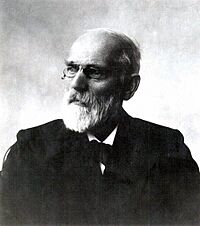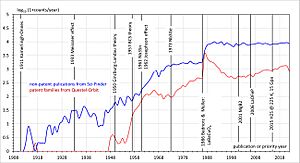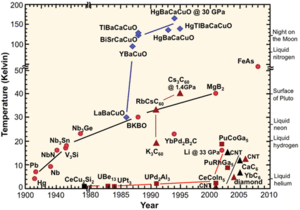History of superconductivity facts for kids
Superconductivity is a cool science trick where certain materials can carry electricity with absolutely no resistance. Imagine a super-fast highway for electricity! This means no energy is lost as heat, which usually happens with normal wires. These special materials also push away magnetic fields when they get super cold, below a certain temperature.
The story of superconductivity began in 1911. A Dutch scientist named Heike Kamerlingh Onnes first found this amazing property in mercury. Since then, scientists have found many more superconducting materials. They have also worked hard to understand how superconductivity works. This field is still a very active area of study in condensed matter physics, which looks at how materials behave.
The history of superconductivity is full of exciting moments. Each big discovery has led to many more scientific papers and patents, as you can see in the picture. For over 100 years, scientists have published ten times more papers than patents about superconductivity. This shows that it's a technology that hasn't yet become a huge commercial success, but it's still very important for research.


Contents
Exploring Super Cold Science (Before 1908)
Scientists have always been curious about how materials behave at very cold temperatures. James Dewar started looking into how electrical resistance changes when things get super cold. He and John Ambrose Fleming thought that at absolute zero (the coldest possible temperature), pure metals would become perfect conductors. This means they would carry electricity with no resistance at all.
Later, Walther Nernst developed the third law of thermodynamics. This law says that absolute zero can never actually be reached. Around the same time, Carl von Linde and William Hampson both found ways to turn gases into liquids. They used a process called the Joule–Thomson effect. Their methods combined to create the Hampson–Linde liquefaction process, which was a big step in making very cold temperatures.
Heike Kamerlingh Onnes bought a Linde machine for his research. Even Nikola Tesla got a patent in 1900 for making electrical signals stronger by cooling them down. He believed that colder temperatures would lower resistance, making his devices work better.
A huge breakthrough happened on July 10, 1908. Heike Kamerlingh Onnes, working at Leiden University in the Netherlands, successfully made liquid helium for the first time. Liquid helium is incredibly cold, boiling at about -269°C (4.2 Kelvin). This achievement opened the door to many new discoveries.
The Amazing Disappearance of Resistance
After making liquid helium, Heike Kamerlingh Onnes and Jacob Clay continued to study how resistance changes at very low temperatures. They started with platinum and gold, but then switched to mercury because it was easier to purify.
On April 8, 1911, at 4 PM, Onnes made a historic note: "Kwik nagenoeg nul," which means "Resistance of mercury almost zero." He saw that at 4.19 Kelvin (about -268.96°C), the mercury's electrical resistance suddenly vanished! His measuring device showed no resistance at all.
Onnes shared his discovery in a paper called "On the Sudden Rate at Which the Resistance of Mercury Disappears." He explained that the mercury's resistance became thousands of times less than even the best normal conductors. He also found that if he warmed the mercury back up to 4.2 Kelvin, the resistance would return.
The next year, Onnes published more about this strange phenomenon. He first called it "supraconductivity," but later changed it to "superconductivity." For his groundbreaking work, he won the Nobel Prize in Physics in 1913.
In 1912, Onnes did another cool experiment. He put an electric current into a superconducting ring and then removed the battery. When he measured the current later, he found it was still flowing! The current kept going because the material was in a superconducting state. This showed how powerful superconductivity could be.
Over the next few decades, scientists found superconductivity in other materials. In 1913, they found it in lead at 7 Kelvin. In the 1930s, they found it in niobium at 10 Kelvin, and in 1941, in niobium nitride at 16 Kelvin.
Solving the Superconductivity Puzzle (1933–1979)
A big step in understanding superconductivity happened in 1933. Walther Meissner and Robert Ochsenfeld discovered something amazing: superconductors push away magnetic fields. This is now known as the Meissner effect. Imagine a magnet floating above a superconductor – that's the Meissner effect in action!
In 1935, brothers Fritz London and Heinz London explained that the Meissner effect happens because superconductors try to use the least amount of energy possible. Then, in 1950, Lev Landau and Vitaly Ginzburg created a theory called the Ginzburg–Landau theory. This theory helped explain how superconductors behave on a larger scale.
Alexei Abrikosov later used the Ginzburg–Landau theory to show that there are two types of superconductors: Type I and Type II. Abrikosov and Ginzburg won the Nobel Prize in Physics in 2003 for their work. Also in 1950, scientists found that a superconductor's critical temperature (the temperature where it becomes superconducting) depends on the weight of its atoms. This discovery hinted that the way electrons and vibrations in the material interact is key to superconductivity.
Scientists like Bernd T. Matthias, John Kenneth Hulm, and Theodore H. Geballe discovered hundreds of new low-temperature superconductors in the 1950s. Matthias even came up with "Matthias rules" in 1954. These were helpful guidelines for finding new superconducting materials.
BCS Theory: The Big Explanation
The full scientific explanation for superconductivity finally arrived in 1957. John Bardeen, Leon Cooper, and John Robert Schrieffer developed the BCS theory. This theory explained that superconducting current flows because electrons team up in pairs, called Cooper pairs. They do this by interacting with vibrations in the material. For this amazing work, they won the Nobel Prize in Physics in 1972.
Little–Parks Effect
The Little–Parks effect was discovered in 1962. Scientists found that if you put a thin, empty superconducting cylinder in a magnetic field, its electrical resistance changes in a repeating pattern. This pattern depends on the magnetic field passing through the cylinder.
This effect shows that the temperature at which a material becomes superconducting (its critical temperature) also changes in a repeating way. The Little-Parks effect is a great example of how tiny quantum behaviors of electrons can affect a material on a larger scale.
Superconductivity in Action: Commercial Uses
Right after discovering superconductivity, Kamerlingh Onnes tried to build a super-strong electromagnet using superconducting wires. But he found that even small magnetic fields would destroy the superconductivity in the materials he had.
Much later, in 1955, George Yntema built a small electromagnet using superconducting niobium wire. Then, in 1961, a team of scientists made a huge discovery. They found that a special material made of niobium and tin could carry a massive electric current in a strong magnetic field, even at 4.2 Kelvin.
This niobium-tin material is brittle, but it's now used in supermagnets that create incredibly strong magnetic fields. In 1962, Ted Berlincourt and Richard Hake found that alloys of niobium and titanium were less brittle and also good for magnets. Companies quickly started making wires from these materials.
Niobium-titanium is now the most common material for supermagnets. It's easier to work with, even though its superconducting properties aren't quite as strong as niobium-tin. Both niobium-tin and niobium-titanium are used in MRI machines (for medical imaging), in huge particle accelerators, and many other places. In 2014, it was estimated that superconductivity was essential for about five billion euros worth of global economic activity, with MRI systems making up about 80% of that total.
In 1962, Brian Josephson made an important prediction. He said that a supercurrent could flow between two pieces of superconductor separated by a very thin layer of insulator. This is called the Josephson effect. This effect is used in super-sensitive devices called SQUIDs, which can measure tiny magnetic fields. Josephson won the Nobel Prize in Physics for his work in 1973.
In 1973, a material called Nb3Ge was found to be superconducting at 23 Kelvin. This was the highest temperature for superconductivity at normal pressure for many years.
New Kinds of Superconductors
High-Temperature Superconductors
A huge breakthrough happened in 1986. Johannes Georg Bednorz and Karl Alexander Müller discovered superconductivity in a new type of material called a cuprate perovskite. This material became superconducting at 35 Kelvin. This was a big deal because it was the first of the "high-temperature superconductors." They won the Nobel Prize in Physics in 1987.
Soon after, scientists found that by changing the material slightly (making YBCO), the critical temperature jumped to 92 Kelvin. This was incredibly important because it meant that liquid nitrogen could be used for cooling. Liquid nitrogen boils at 77 Kelvin, and it's much cheaper and easier to get than liquid helium. This opened up many more possibilities for using superconductors.
Many other cuprate superconductors have been found since then. Understanding how superconductivity works in these materials is one of the biggest challenges for scientists today.
In 2001, scientists found that magnesium diboride (MgB2) was superconducting at 39 Kelvin. In 2008, new materials called iron-based superconductors were discovered. Scientists hoped that studying these would help them understand the cuprate superconductors better.
In 2013, scientists even achieved "room-temperature superconductivity" for a tiny fraction of a second in YBCO. They did this by using short pulses of infrared laser light to change the material's structure.
Scientists are still looking for new materials that can become superconducting at even higher temperatures, maybe even at room temperature! This would be a huge step for technology.
Important Papers in Superconductivity History
Papers by H.K. Onnes
- "The resistance of pure mercury at helium temperatures". Comm. Leiden. April 28, 1911.
- "The disappearance of the resistivity of mercury". Comm. Leiden. May 27, 1911.
- "On the sudden change in the rate at which the resistance of mercury disappears". Comm. Leiden. November 25, 1911.
- "The imitation of an ampere molecular current or a permanent magnet by means of a supraconductor". Comm. Leiden. 1914.
Other Key Papers
- F. London and H. London, "The electromagnetic equations of the supraconductor," Proc. Roy. Soc. (London) A149, 71 (1935), ISSN 0080-4630.
- V.L. Ginzburg and L.D. Landau, Zh. Eksp. Teor. Fiz. 20, 1064 (1950)
- A.A. Abrikosov, "On the magnetic properties of superconductors of the second group," Soviet Physics JETP 5, 1174 (1957)
Patents
- Tesla, Nikola, U.S. Patent 685,012 "Means for Increasing the Intensity of Electrical Oscillations", March 21, 1900.
See also
- Superconductivity
- Macroscopic quantum phenomena
- Timeline of low-temperature technology
- Technological applications of superconductivity
- High-temperature superconductivity




